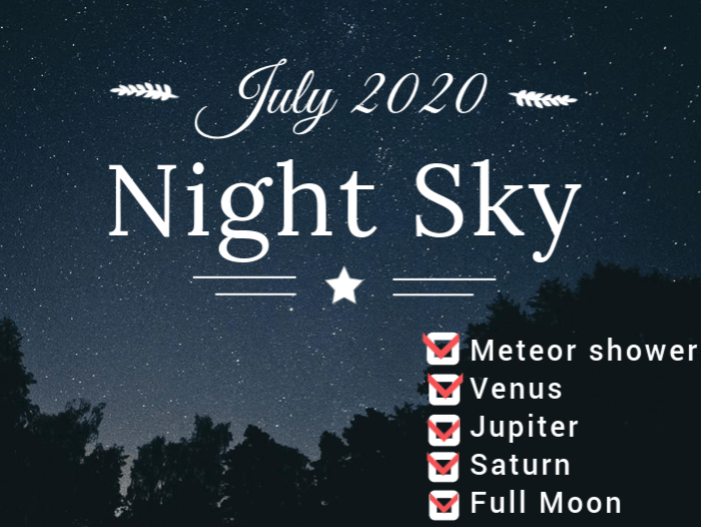We cannot believe it is July already! The weather is warm and the nights are starting to get longer. So let’s go stargazing! There is a lot up there to see in July 2020. Make sure to save these dates in your calendar!
Saturday July 4th: Earth at Aphelion
Yes, it is the day when your hairdresser will finally reopen! But it is also the day when the Earth will reach Aphelion, the furthest point from the Sun. This will happen at 12:34 BST. At that moment we will be 152,095,295 km away from our star. Pretty far, isn’t it?
Many people think that the Earth is close to the Sun in the Summer and far away from the Sun in the Winter. But the opposite is true! This confusion stems from the misconception on what causes seasons. If you are feeling confused too, please read our post Seasons on Earth and other planets explained.
Sunday July 5th: Full Moon and Penumbral Eclipse
The Full Moon will occur at 5:44 AM BST on July the 5th. The July Full Moon is often called The Buck Moon as this is the time when deer begin to grow their antlers.
You might have seen on the news that during this Full Moon there will be a “spectacular Buck Moon Penumbral Lunar Eclipse”. Well…penumbral eclipse – yes, spectacular – unfortunately no!
Penumbral eclipses occur when the Moon, partly or fully, enters the Earth’s penumbra (aka the partial shadow), i.e. the outer part of the Earth’s shadow that some of the light from the Sun is still able to reach. It happens when the Sun, the Earth and the Moon are not perfectly aligned. On July 5th only part of the Moon will enter the Earth’s penumbra causing a very slight darkening of the top ⅓ of the Moon. But chances are, you will not notice any difference even if you look!
Friday July 10th: Venus reaches greatest illuminated extent
We know that planet Venus shines brightly in the sky, but some days it is brighter than others. On the morning of July 10th the planet will reach what astronomers call “the greatest illuminated extent” and will appear brighter than ever! Don’t forget that in July 2020 Venus shines as a morning star, so set up your alarm bright and early!
Monday July 13th: Last Quarter Moon
The Last quarter Moon will occur at 0:29 AM BST on July 13. Weather permitting, you will get to see a half of the lunar disc lit by the Sun. Can you tell which half, left or right, would it be (as seen from the Northern Hemisphere)?
Tuesday July 14th: Jupiter at opposition
In the morning of July 14th Jupiter will reach its opposition, that means the planet, the Earth and the Sun will be on the same line. This is a great time to observe Jupiter, as it will look its biggest and brightest. But if the weather is not right (the UK gets quite a few cloudy nights in July), don’t worry. The gas giant will be an easy (bright and beautiful) target all month long!
If you own a pair of binoculars or a telescope, bring them along! You will be able to spot Jupiter’s famous Galilean Moons: Europa, Io, Ganymede and Callisto.
By the way, did you know that in the 17th century the Dutch astronomer Ole Roemer made the first measurement of the speed of light by observing one of Jupiter’s moons? You can find out more about Roemer’s experiment in our post Early Astronomical measurements.
Monday July 20th: Saturn at opposition and New Moon
The New Moon will occur at 18:32 BST on July 20th.
On the same day, late in the evening, planet Saturn will reach its opposition. We will get a perfect opportunity to see Saturn shining its brightest next to dazzling Jupiter on a moonless night. What a sight that would be! Unfortunately, to observe Saturn’s famous rings you will still need special equipment.
Thursday July 30th: Southern Delta Aquariids reach maximum
The Southern Delta Aquariids is not the most abundant shower. At maximum, we can expect somewhat between 5 (in the city) and 10 (in the dark location) meteors per hour rate, so please be patient! The Moon will be 70% full around the shower’s maximum- which is less than ideal for spotting the rather faint Southern Delta Aquariids meteors. But any shooting star is a shooting star, so we are determined to try!
The radiant of the shower lies between the constellations Aquarius the Water Bearer and Capricornus the Sea Goat. The best time for meteor spotting will be at dawn, when the radiant reaches its highest point and after the Moon sets.
If you are new to stargazing, these Open source planetarium software and free night sky apps for stargazers will help you not to get lost in the night sky! Alternatively, you can visit our Star Dome for a guided tour of the heavens!
Happy July 2020 stargazing!

